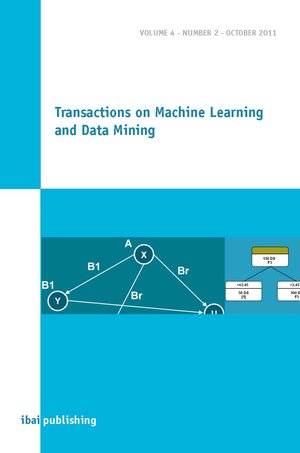
×
![Buchcover ISBN 9783942952071]()
Wissenschaftler
Transactions on Machine Learning and Data Mining
Volume 4 - Number 2 - October 2011
herausgegeben von Petra PernerThe present journal issue contains three papers on very important multimedia data
mining applications.
The first one by Huang and Haralick is concerned with the recognition of text
pattern by a new graphical model. It is probabilistic in nature and based on CRFs,
HMMS, and MEMMS but takes into account the special aspects of the application. It
is a new step into the direction of recognizing documents concerned with a certain
topic that are available online or arrive in temporal sequence. The method will be a
break through in summarizing the heavy content that is created for one topic all over
the world.
The second paper by Lunga and Ersoy deals with remote sensing images. These
images contain a lot of low-level image features that are hardly to transform into
higher-level features. Because of that it is highly likely that they may run into the
course of dimensionality problem. They show for the particular application that
feature reduction can be done by transforming the features into another space that
preserves the spacial relation of the pixel. The paper is a new valuable paper of the
specific topic “feature transformation” of the MLDM and ICDM data mining
community. Special similarity measures are proposed for classification. It shows once
more that the application of the nearest neighbor rule and case-based reasoning can
lead to superior performance of a system.
The third paper by Attig and Perner deals with feature description and
classification for medical applications in particular colon image classification.
Texture seems to be a good descriptor for describing the appearance of different
objects in medical images without going into more detailed low-level feature
descriptions. However the texture descriptor should be able to model the different
appearances of the objects very fine grained and in a flexible way. The work evaluates
the texture features derived from the co-occurrence matrix and the texture features
based on Random Sets. It shows that Random Sets are a flexible method to model
different 2-D textures in medical images in efficient way.
mining applications.
The first one by Huang and Haralick is concerned with the recognition of text
pattern by a new graphical model. It is probabilistic in nature and based on CRFs,
HMMS, and MEMMS but takes into account the special aspects of the application. It
is a new step into the direction of recognizing documents concerned with a certain
topic that are available online or arrive in temporal sequence. The method will be a
break through in summarizing the heavy content that is created for one topic all over
the world.
The second paper by Lunga and Ersoy deals with remote sensing images. These
images contain a lot of low-level image features that are hardly to transform into
higher-level features. Because of that it is highly likely that they may run into the
course of dimensionality problem. They show for the particular application that
feature reduction can be done by transforming the features into another space that
preserves the spacial relation of the pixel. The paper is a new valuable paper of the
specific topic “feature transformation” of the MLDM and ICDM data mining
community. Special similarity measures are proposed for classification. It shows once
more that the application of the nearest neighbor rule and case-based reasoning can
lead to superior performance of a system.
The third paper by Attig and Perner deals with feature description and
classification for medical applications in particular colon image classification.
Texture seems to be a good descriptor for describing the appearance of different
objects in medical images without going into more detailed low-level feature
descriptions. However the texture descriptor should be able to model the different
appearances of the objects very fine grained and in a flexible way. The work evaluates
the texture features derived from the co-occurrence matrix and the texture features
based on Random Sets. It shows that Random Sets are a flexible method to model
different 2-D textures in medical images in efficient way.


